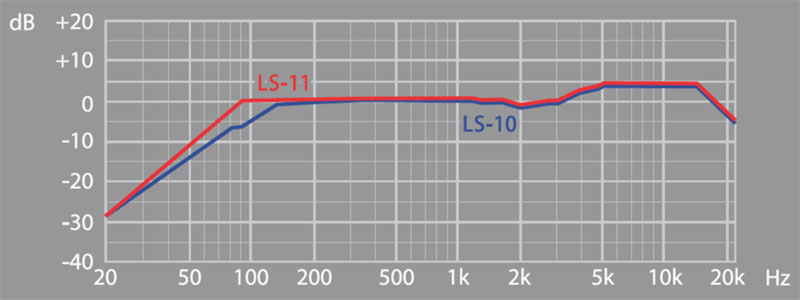Much of the information and the images below are from Recording Hacks web site. Recording Hacks has reviews on many of the microphones we have. I have included images of the frequency response for each microphone below. Please read more at their website.
Student Samples
Mr. Le Duc’s Sample Recording
With and Without Pro Microphones
iPhone Sound
Pro Mic Sound
The Microphones
Studio Projects C1
- The C1 is a cardioid, large-diaphragm condenser microphone
- Compares with professional microphones costing 10 times more
- Good for many recording situations including voice, instruments, etc.
- Read more: http://recordinghacks.com/microphones/Studio-Projects/C1

Below is the Neumann U87 for comparison with the Studio Projects C1 priced at $360 and a Neumann U87 Ai legendary microphone that is priced at over $4,600.

Shure SM58
- The SM58 is a cardioid dynamic microphone
- Perhaps the most widely known vocal mic in the world, the SM58 celebrates its 55th anniversary in 2021
- Read more: http://recordinghacks.com/microphones/Shure/SM58
- Check out the SM58 Torture Test

Shure SM7B
- The Shure SM7B is an industry-standard cardioid dynamic microphone.
- It has a reputation for being a go-to studio mic for numerous sources, including vocals.
- It is also a popular live stream, podcast, and radio microphone
- Read more: http://recordinghacks.com/microphones/Shure/SM7B

Sennheiser e609
- The e609 is a super-cardioid dynamic microphone
- Designed for recording guitar cabinets face-on and extremely close to the source
- Provides isolation from other onstage signals
- Also suitable for recording drums, especially toms
- Read more: http://recordinghacks.com/microphones/Sennheiser/e906
- Watch the overview video for guitar amp recording

Electro-Voice RE-20
- The RE-20 is a cardioid dynamic microphone
- It is designed for the radio and television broadcast market
- It is an end-address dynamic tailored for close-recorded vocals like podcasting, YouTube streaming, and close-up singing
- Read more: http://recordinghacks.com/microphones/Electro-Voice/RE20

AKG C1000S
- The C1000S is a cardioid small-diaphragm condenser microphone
- It has been used for live music, broadcast vocals, podcasting, and instrument miking
- It is called the Swiss army knife of recording
- Read more: http://recordinghacks.com/microphones/AKG-Acoustics/C-1000-S

Blue Baby Bottle
- The Baby Bottle is a pressure-gradient cardioid condenser
- Has a smooth and natural midrange and doesn’t have excessive high-end sizzle
- Read more: http://recordinghacks.com/microphones/Blue-Microphones/Baby-Bottle

Microphone Polar Patterns (How the mic ‘hears’)
Polar pattern images from Wikipedia by Wikimedia Commons user Galak76
(Microphones are facing the top of blog page)
Omnidirectional (used to pick up ambient, public, natural sound)
Bi-directional or Figure of 8 (used to mimic stereo sound like our ears)
Subcardioid
Cardioid (from the Greek καρδία “heart”)
Hypercardioid
Supercardioid
Shotgun (used in primarily in film)
Recording Tips
“A common problem when recording vocalists, particularly if they are more familiar with live performance than studio work, is of that they can get much too close to the microphone, causing popping, sibilance, excessive bass boost, and creating humidity problems. Very large foam windshields might help, but a separate pop shield (the nylon stocking on a wire frame idea) mounted four or five inches in front of the mic is better. An alternative technique is to rig a microphone for the vocalist to ‘eat’ with a second mic positioned something like eight inches further back and six inches higher. Normally you would record only the sound of the distant (normally a decent capacitor mic), but if you rig a conventional live-performance dynamic model as the close mic and mix in some of that mic’s signal, you can achieve a more interesting and slightly aggressive sound!”
– from 20 Tips On Using Microphones at SoundonSound.com
Other Recording Devices
Zoom H4N Digital Multi-track Recorder
- The Zoom H4N is a stereo condenser microphone recorder
- It has two microphones at 90 degree angles from each other to reproduce stereo sound
- It can be mounted on top of a camera or used separately to record sound effects, Foley, etc.
Olympus PCM LS-11 Video Tutorial
Olympus PCM LS-11
- The Olympus PCM LS-11 is a stereo condenser microphone recorder
- It has two microphones at 90-degree angles from each other to reproduce stereo sound similar to the human ear
- Read more: http://www.amazon.co.uk/Olympus-LS-11-Linear-PCM-Recorder
- Read the Users Manual and examine the best recording setting for the event

Apple iPhone, Ear Pod, or Cell Phone Microphones
- These microphones are probably MEMS (MicroElectrical-Mechanical System) microphones
- MEMS microphones are a type of condenser microphone
- Read more: https://en.wikipedia.org/wiki/Microphone#MEMS_microphone

Resources for the Microphone Audition
- The Script (PDF)

You must be logged in to post a comment.